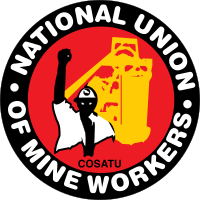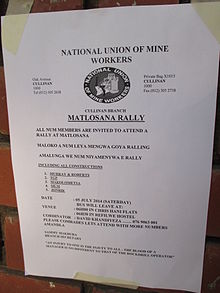National Union of Mineworkers (South Africa)
 From Wikipedia - Reading time: 11 min
From Wikipedia - Reading time: 11 min
National Union of Mineworkers | |
 | |
| Founded | 1982 |
|---|---|
| Founder | Cyril Ramaphosa |
| Merger of | |
| Location | |
| Members | 300,000 (2014) |
| William Mabapa | |
| Daniel Balepile | |
| Affiliations |
|
| Website | www |
| https://en.wikipedia.org/wiki/IndustriALL_Global_Union | |
The National Union of Mineworkers (NUM) is a mainly mining industry related trade union, an organisation of workers with common goals through organised labour, in South Africa. With a membership of 300,000 as of 2014[update], it is the largest affiliate of the Congress of South African Trade Unions (COSATU).
History
[edit]The union was founded in 1982 as a black mine workers union, on the initiative of the Council of Unions of South Africa. Its first leader was Cyril Ramaphosa, under whom it grew rapidly, winning bargaining recognition from the Chamber of Mines in 1983.[1]: 51
NUM campaigned successfully in the 1980s for the end of the job reservation system, a system which ensured that the best-paid jobs were allocated to whites. The union was a founding affiliate of the Congress of South African Trade Unions in 1985.[2] In 2001, it absorbed the Construction and Allied Workers' Union,[3] while in 2021 it absorbed the Liberated Metalworkers' Union of South Africa.The merger was completed in 2021.[4]
NUM was affiliated internationally with the International Federation of Chemical, Energy, Mine and General Workers' Unions.
2007 strike
[edit]On 4 December 2007, the Union went on strike to protest working conditions in South Africa's mines. The strike was spurred on by a rise in worker fatalities from 2006 to 2007, despite a government plan in October to reduce fatalities. Less than 5% of mineworkers came to work on that day.[5]
2012 wildcat strikes
[edit]
On 10 August 2012, thousands of NUM members began a series of wildcat strikes at Lonmin's Marikana mines linked to demands for increased pay. The following day, NUM leaders allegedly opened fire on striking NUM members who were marching to their offices to demand support from their union - an incident now acknowledge as the first violent incident during the strikes.[6][7][8][9] It is said in the media that the killing of two striking miners was a central reason for the breakdown in trust within the union amongst workers.[10][11] In a submission to the Farlam Commission, NUM has said that lethal force on this day was justified.[12][13]
It is estimated that between 12 and 14 August about nine people (at least four miners, two police officers and two security guards) were killed in the area around Marikana - though there is conflicting reports on who killed whom during these dates.[14][15][16][17]
On 16 August, police opened fire on a group of miners who had gathered on a hill near Nkaneng, at least 34 people were killed at Marikana, 78 were injured and 259 were arrested.[18] The miners were carrying machetes and had refused a request to disarm. According to the Congress of South African Trade Unions, police had first used tear gas, water cannons and then used "live ammunition".[19] The killings have been labelled a massacre throughout the media with police, Lonmin and NUM itself being blamed.[20][21][22]
Revelations on the incident starting with academic investigations[citation needed] and then followed up by reporting by Greg Marinovich[23] has shown that most of the killings happened off camera many minutes after some of the murders were recorded on television.
According to the New York Times, "Frans Baleni, general secretary of the National Union of Mineworkers, defended the police in an interview with Kaya FM, a radio station" saying that "The police were patient, but these people were extremely armed with dangerous weapons."[24]
The shooting was one of the worst by the South African authorities since the end of the apartheid era in South Africa.[25] Baleni and other NUM officials have also accused 'third forces' of being behind the Marikana strikes.[26][27]
Loss of support
[edit]It has been argued that there has been an exodus from NUM.[28] According to Justice Malala, writing in The Guardian, "The NUM has lost all credibility and is bleeding members. Its already well-paid secretary, Baleni, was awarded a salary increase of more than 40% last year and his total salary package is just more than R105 000 a month. NUM leaders have refused to get out of police armoured vehicles to address workers."[29] Others have also argued that NUM's membership numbers are inflated and, now, as a result of the strikes in the North West, its membership likely stands at around 150,000.[30]
Others praised the organisation. An editorial in Business Day said "The NUM is the thoughtful, considered heart of the union movement here... It appreciates and values private capital and strong companies."[31]
The rival union the Association of Mineworkers and Construction Union (AMCU) has increased in membership since the Marikana shootings and now represents over 40% of employees at Amplats[32] and 70% at Lonmin.[33]
Leadership
[edit]General Secretaries
[edit]- 1982: Cyril Ramaphosa
- 1991: Kgalema Motlanthe
- 1998: Gwede Mantashe
- 2006: Frans Baleni
- 2015: David Sipunzi
- 2022: William Mabapa
Presidents
[edit]- 1982: James Motlatsi
- 2000: Senzeni Zokwana
- 2014: Piet Matosa
- 2018: Joseph Montisetse
- 2022: Daniel Balepile
Further reading
[edit]- ICTUR; et al., eds. (2005). Trade Unions of the World (6th ed.). London, UK: John Harper Publishing. ISBN 0-9543811-5-7.
References
[edit]- ^ Pretorius, Fransjohan (2014). A History of South Africa: From the Distant Past to the Present Day. Hatsfield, Pretoria: Protea Book House. ISBN 978-1-86919-908-1.
- ^ "Sweet Food and Allied Workers Union (SFAWU)". South African History Online. Retrieved 14 March 2021.
- ^ "Size counts". Mail & Guardian. 12 January 2001. Retrieved 14 March 2021.
- ^ Sidimba, Loyiso. "Cosatu affiliates Limusa, NUM merge". IOL. Retrieved 27 May 2023.
- ^ "South African miners out on strike". English.aljazeera.net. Retrieved 10 August 2018.
- ^ "Marikana Prequel - NUM and the murders that started it all". Daily Maverick. 12 October 2012.
- ^ "South Africa: Marikana massacre – a turning point?". Links. 27 August 2012.
- ^ "NUM shot at us - witness". Independent Online. 2 October 2012.
- ^ Sosibo, Kwanele (22 October 2012). "NUM: Lethal force ahead of Marikana shootings was justified". Mg.co.za. Retrieved 10 August 2018.
- ^ Sacks, Jared. "Marikana prequel: NUM and the murders that started it all - Daily Maverick". Dailymaverick.co.za. Retrieved 10 August 2018.
- ^ "Marikana 20 years in the making". Business Report. 21 October 2012. Retrieved 23 October 2012.
- ^ Sosibo, Kwanele (22 October 2012). "NUM: Lethal force ahead of Marikana shootings was justified". Mg.co.za. Retrieved 10 August 2018.
- ^ "TimesLIVE". Timeslive.co.za. Retrieved 10 August 2018.
- ^ "Miners killed like possessed vermin". Mail & Guardian. 23 October 2012. Retrieved 23 October 2012.
- ^ Tau, Poloko (14 August 2012). "Cops killed as conflict spirals at Lonmin". Iol.co.za. Retrieved 19 August 2012.
- ^ "South African platinum mine union riots 'kill nine'". BBC News. 13 August 2012. Retrieved 17 August 2012.
- ^ "Marikana inquiry updates". Times Live. 23 October 2012. Retrieved 23 October 2012.
- ^ "Lonmin massacre: a timeline - IOL News". Iol.co.za. Retrieved 10 August 2018.
- ^ "270 miners charged in co-workers' deaths". Edition.cnn.com. Retrieved 30 August 2012.
- ^ "Strike until NUM leaders step down, Malema tells SA's miners". Ng.co.za. Retrieved 10 August 2018.
- ^ "SAPS blames Lonmin for Marikana strikers deaths". Business Day.
- ^ "Finger pointing key at Marikana inquiry". Iol.co.za. Retrieved 10 August 2018.
- ^ "The murder fields of Marikana. The cold murder fields of Marikana". Daily Maverick. 8 September 2012. Archived from the original on 30 August 2012. Retrieved 25 October 2012.
- ^ Mine Strike Mayhem Stuns South Africa as Police Open Fire, Lydia Polgreen, The New York Times, 16 August 2012
- ^ "South African police open fire as striking miners charge, killing and wounding workers". The Washington Post. 16 August 2012. Archived from the original on 17 August 2012. Retrieved 16 August 2012.
- ^ Marikana prequel: NUM and the murders that started it all, Jared Sacks, Daily Maverick, 12 October 2012
- ^ Activists decry talk of third force at Marikana, Mail & Guardian, 24 August 2012
- ^ Ramaphosa can't stop exodus from the NUM, Jan de Lange, Mining MX, 6 May 2013,
- ^ The Marikana action is a strike by the poor against the state and the haves, Justice Malala, The Guardian, 17 August 2012
- ^ A NUM sized headache and no one else to blame, Mandy de Waal, The Daily Maverick, 24 October 2012
- ^ A failure of our society on many levels, Editorial, Business Day, 17 August 2012
- ^ "Amcu seals place as top dog platinum union". Miningmx.xom. Retrieved 10 August 2018.
- ^ "Amcu and NUM face off on issues". Archived from the original on 23 June 2013.
External links
[edit]- NUM official site.
 KSF
KSF